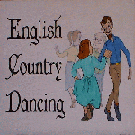User Tools
Sidebar
O'er Boggie
Walsh, 1735.
Interpreted by Andrew Shaw
Longwaps, duple minor
Tune: Ore Boggy
A1 1-2 Ist man leads his ptn. down into 2nd place, turning to face 2nd wo., as 2nd cpl.
move up the outside into I" place, turning in to face down, then Ist cpl. &
2nd wo. set R. & L.
3-4 Ist man {improper) leads his ptn. back up into Ist place, turning to face 2nd
man, as 2nd cpl. move back down the outside into 2nd place, turning in to
face up, then Ind cpl. & 2nd man set R. & L.
A2 1-4 Star R. & L.
BI 1-2 Ist cpl. short cast down into 2nd place, 2nd cpl. leading up into Ist place, then
Ist cpl. set R. & L.
3-4 Ist cpl. lead down through the cpl. below and cast back.
B2 1-2 Ptns. facing, R. & L. 4 changes without hands {2 steps per change).
3-4 Ist cpl. 2-hand turn once round.
Video: https://www.youtube.com/watch?v=O7XzPrWHpBk
Note on the title: According to Charles MacKay's Dictionary of Lowland Scotch (1888), to go “ower Bogie” was an expression used to describe a wedding conducted by a magistrate rather than a clergyman, the Aberdeenshire equivalent of a Gretna Green wedding in Dumfriesshire. The River Bogie was close to the border of Aberdeenshire and Banffshire.
Note on the dance: The Craftsman, which first appears in the 2“ edition of Walsh's The Compleat Country Dancing-Master [Book 1], 1731, then in the same Johnson collection as 0'er Boggie, seems to be an earlier version of the same figure, with minor variations, set to a different tune. Ore Boggy in John and William Neal's Choice Collection of Counztry Dances (Dublin, [c1726]) sets a different figure to the tune and, strangely, reverses the order of the A and B phrases of the music. In his 1816 Companion to the Ball Room, Thomas Wilson set three new figures to the tune.


